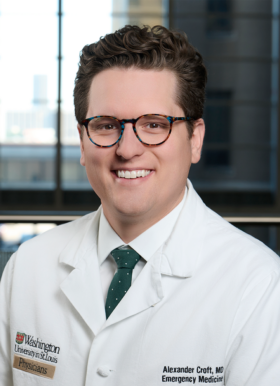Simulation has been a component of emergency medicine resident education at Washington University School of Medicine for decades. We strive to create an inclusive space where individuals can practice, reflect and grow. We employ a number of techniques including debriefing, coaching, deliberate practice and mental modeling to achieve this goal.
Within the Department of Emergency Medicine’s, we employ the Active Learning and Dissemination and Implementation (ALDI) space within our department lounge. This space has a range of high- and low-fidelity mannequins spanning infancy to adulthood — including pregnancy. Additionally, we have a host of procedural trainers to augment the clinical procedural training.
We are fortunate to partner with the Howard and Joyce Wood Simulation Center and the Washington University Institute for Surgical Education (WISE Lab). The Wood Simulation Center houses four state-of-the-art high-fidelity mannequins and a task training room. A large conference room allows for remote viewing of the lab rooms. The WISE Lab is a unique large space with multiple areas for procedural training. It has a range of services that enable our residents to conduct annual critical procedure labs.
Lastly, through the generous gifts of the Barnes Jewish Foundation and the American Heart Association, we direct and manage the In-Situ Simulation Acute Care (ISSAC) Program. This multidisciplinary and interprofessional group of educators seek to bring simulation out of the lab and into the clinical space, with a mission to improve the education, operations and quality of care provided.
Whether it’s a crash Cesarean section or a critical trauma patient, we try to have you practice in the lab before you have to do it in real-life.
Our innovative, multi-faceted simulation curriculum is deliberately crafted for synergy and to allow our residents opportunities to continue their growth throughout their four years with us.
For conference simulations, we run larger group labs roughly every other month during our weekly conference. Half of the residents get small group active-learning time while the other half comes to the simulation lab. After two hours, we swap. This allows for hands-on education in a smaller group while still encouraging you to solve the cases as a collective. It provides a great opportunity for our junior residents to model what they see their seniors doing in the ED but in a psychologically safe environment. We frequently partner with other specialties and residencies for joint training in this environment as well.
We also have a Year-Directed Simulation (YDS) curriculum, which is designed to target our learners exactly where they are in their training. Including such topics as advanced neonatal resuscitation, death notification and mock interviews, we strive for excellence in all phases of training. To cap this, we host an annual Transition Day in May, when we prepare each resident for their next set of graduated responsibilities.
Lastly, we host an annual Outdoor Simulation Day. Taking advantage of nearby Forest Park — rated by the USA Today to be America’s Best City Park in 2023 — we move the simulation lab outside for a day of fun and learning. Whether it is treating venomous snake bites in the St. Louis Zoo or responding to a simulated mass casualty incident, the Outdoor Simulation Day is a treasure within our residency curriculum.
Importantly, our curriculum is always improving and growing. We welcome residents, medical students, fellows and faculty with all ideas for new ways to deliver active learning.
For more information, contact:

Ernesto J Romo, MD
Director, Simulation; Department Equity Champion; Assistant Professor, Emergency Medicine
- Phone: 314-362-9916
- Email: eromo@nospam.wustl.edu

Alexander Croft, MD
Assistant Medical Director, Howard and Joyce Wood Simulation Center; Co-Director, Simulation; Director, In-Situ Simulation Acute Care (ISSAC) Program; Assistant Professor, Emergency Medicine
- Email: acroft@nospam.wustl.edu